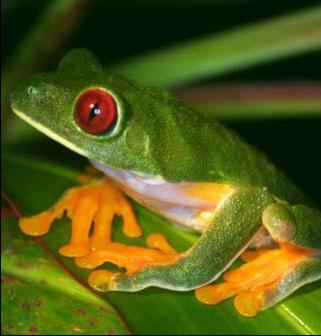
|
 Red Eyed Tree Frog

 The Red-eyed tree frog is a slender, delicate frog with webbed hands and feet
and is one of the most common tree frogs kept in captivity as pets, perhaps
because of their vivid colors and overall beauty. They are medium sized frogs,
with females reaching around 3.5 inches in length, and males around 3 inches.
They begin their lives under water and later
spend their adult life on land. They inhabit
low and tropical forests in
Veracruz and Oaxaca, Mexico, into
Central America, Panama and Costa
Rica, and farther south into Columbia,
South America. Their environment is
rather warm year-round with high levels
of humidity. Like most amphibians,
they are dependent on water for most
of their life. In the forests of Belize,
the Red-eyed tree frog minimizes water
loss by resting underneath leaves
and tucking its limbs up close to its body.
They are quite a common site for locals
and tourists in some regions and
often invade public areas close to the
forests.
The Red-eyed tree frog is a slender, delicate frog with webbed hands and feet
and is one of the most common tree frogs kept in captivity as pets, perhaps
because of their vivid colors and overall beauty. They are medium sized frogs,
with females reaching around 3.5 inches in length, and males around 3 inches.
They begin their lives under water and later
spend their adult life on land. They inhabit
low and tropical forests in
Veracruz and Oaxaca, Mexico, into
Central America, Panama and Costa
Rica, and farther south into Columbia,
South America. Their environment is
rather warm year-round with high levels
of humidity. Like most amphibians,
they are dependent on water for most
of their life. In the forests of Belize,
the Red-eyed tree frog minimizes water
loss by resting underneath leaves
and tucking its limbs up close to its body.
They are quite a common site for locals
and tourists in some regions and
often invade public areas close to the
forests.

The Red-eyed tree frog is a slender, delicate frog with webbed hands and feet
and is one of the most common tree frogs kept in captivity as pets, perhaps
because of their vivid colors and overall beauty. They are medium sized frogs,
with females reaching around 3.5 inches in length, and males around 3 inches. |
The Red-eyed tree frog is a slender,
delicate frog with webbed hands and
feet and is one of the most common
tree frogs kept in captivity as pets, perhaps
because of their vivid colors and
overall beauty. This frog exhibits a brilliant
display of colors with it’s emerald
green head and back, sky blue inner
legs, creamy white to yellow and
bright blue striped sides and orange
toes. The dorsal coloration changes
from bright, almost fluorescent green,
to darker, forest green during different
times of the day, and in response to
temperature and mood changes. The
most notable characteristic is the huge,
red eyes that seem to bulge out of the
heads of these frogs. Their color and
size vary depending upon their geographic
origination. Those originating
from the northernmost ranges, such as
south Mexico and Guatemala, are
smallest and usually display light blue
flanks and yellowish orange toes. Those
originating from more southern regions,
such as Nicaragua and Costa
Rica, tend to be larger in size and display
much more brilliant colors such
as deep blue to bluish purple flanks,
sky blue inner thighs, and bright orange
toes. They also exhibit creamy white
bellies, some will have white freckles
on their dorsal surface and all have
vertical pupils which are uncommon to
the hylid family – all of which add to
their stunning beauty. They are medium
sized frogs, with females reaching
around 3.5 inches in length, and
males around 3 inches. The feet are

The most notable characteristic of this tree frog is the huge, red eyes that seem
to bulge out of its head. If disturbed while resting, they may abruptly open their
enormous eyes and move their legs out to show the bright coloration, in an attempt
to startle the intruder. |
large, consisting of typical toe pads that
aid in attaching to leaves. Juvenile
morphs are brownish green, and
change to bright green as they mature.
In the wild, and in captivity, these
nocturnal frogs typically spend their
days attached to green leaves, sometimes
in small groups. They position
themselves in such a way so as to disguise
every colorful part of their body
in an attempt to blend into the leaves.
They do this so well that they are often
difficult to find. Their habitat is crawling
with potential predators, including
bats, snakes, birds, small mammals,
insects and lizards. This frog is not
toxic, and so they rely heavily on camouflage
and discretion to avoid predation.
During the day light hours, these
frogs spend their time sleeping on the
undersides of green leaves, for which
they blend into nicely. While resting,
the brightly colored sides are covered
by the rear limbs, and the eyes are covered
with a mesh-like membrane, so
that the frogs are almost entirely camouflaged green. This may work well in
most cases, however, predators are not
always fooled. If disturbed while resting,
they may abruptly open their enormous,
red eyes, and move the legs out
to show the bright coloration, in an attempt
to startle the intruder. By confusing
predators in this way, the frogs
may gain a split second to leap or climb
away. While awake they are at higher
risk of predation than when sleeping
camouflaged against green leaves. The
bright colors found on the sides of these
frogs are often referred to as “flash
colors,” as they are flashed to potential
predators. This may throw off those
predators that rely mainly on visual
prey detection, such as snakes and
birds, by leaving a “ghost image” in
place of the escaped frog. This is similar
to the effects of gazing at a bright
light or object for a period of time, resulting
in the image being “burned” into
the eyes when you look away. Still, despite
their unique defense methods, they
are preyed upon regularly.

This colorful tree frog is a “poster child” for rainforest conservation. |
The Red-eyed tree frog, a strict carnivore,
is also an avid and skilled hunter.
It eats mostly insects, such as crickets,
moths, flies and beetles, catching them
with its long, sticky tongue. It also eats
other small invertebrates and sometimes
will even other eat small frogs. Most individuals
are strictly nocturnal, and will
only feed at night.
Red-eyed tree frogs spend their lives
near water because they must return to
the water to lay their eggs. Like many
tropical frogs, red-eyed tree frogs enter
breeding mode during the rainy season.
At this time, the males will croak incessantly
to attract females, and will wrestle
other males in the near vicinity. In addition
to croaking, males are known to
“quiver” during the breeding season. This
occurs at the peak of a croak, while facing
another male. During this staring contest,
any sign of movement from one frog
prompts a wrestling match between the
males. Breeding occurs from October
to March, usually near temporary or
permanent ponds. While locked in an
embrace, the male fertilizes 30 to 50 pale
eggs as the female lays them on a leave
over standing water. In five days the eggs
hatch into tiny brown tadpoles and they
wiggle their way down the leaf to the
water below. The tadpoles breathe with
gills and swim with a tail. It takes the
tadpoles 75 to 80 days to metamorphose
into a frog. As they mature, they lose
their tail, they develop lungs (for breathing
air), and they become brightly colored.
The adult frog will spend most of
the rest of its life in the forest canopy,
often hidden among bromeliads.  Although these beautiful creatures are
not considered threatened, the condition
of their habitat is of great concern. Problems
such as global warming, wetland
drainage, atmospheric and climatic
changes, pollution and deforestation have
all taken a severe toll on the rainforest.
With less rainforest come fewer tree
frogs. Amphibian populations are known
to suffer environmental effects sooner
than other populations. This makes them
a good indicator species. Pictures of the
Red-eyed tree frog are seen all over the
world and they have become a “poster
child” for the Save the Rainforest campaign.
Their bright coloration and their
status as an indicator species makes them
the perfect candidate to bring attention to
this important cause.
Although these beautiful creatures are
not considered threatened, the condition
of their habitat is of great concern. Problems
such as global warming, wetland
drainage, atmospheric and climatic
changes, pollution and deforestation have
all taken a severe toll on the rainforest.
With less rainforest come fewer tree
frogs. Amphibian populations are known
to suffer environmental effects sooner
than other populations. This makes them
a good indicator species. Pictures of the
Red-eyed tree frog are seen all over the
world and they have become a “poster
child” for the Save the Rainforest campaign.
Their bright coloration and their
status as an indicator species makes them
the perfect candidate to bring attention to
this important cause.
Click here to return to the main page for Caribbean Critters
|


 The Red-eyed tree frog is a slender, delicate frog with webbed hands and feet
and is one of the most common tree frogs kept in captivity as pets, perhaps
because of their vivid colors and overall beauty. They are medium sized frogs,
with females reaching around 3.5 inches in length, and males around 3 inches.
They begin their lives under water and later
spend their adult life on land. They inhabit
low and tropical forests in
Veracruz and Oaxaca, Mexico, into
Central America, Panama and Costa
Rica, and farther south into Columbia,
South America. Their environment is
rather warm year-round with high levels
of humidity. Like most amphibians,
they are dependent on water for most
of their life. In the forests of Belize,
the Red-eyed tree frog minimizes water
loss by resting underneath leaves
and tucking its limbs up close to its body.
They are quite a common site for locals
and tourists in some regions and
often invade public areas close to the
forests.
The Red-eyed tree frog is a slender, delicate frog with webbed hands and feet
and is one of the most common tree frogs kept in captivity as pets, perhaps
because of their vivid colors and overall beauty. They are medium sized frogs,
with females reaching around 3.5 inches in length, and males around 3 inches.
They begin their lives under water and later
spend their adult life on land. They inhabit
low and tropical forests in
Veracruz and Oaxaca, Mexico, into
Central America, Panama and Costa
Rica, and farther south into Columbia,
South America. Their environment is
rather warm year-round with high levels
of humidity. Like most amphibians,
they are dependent on water for most
of their life. In the forests of Belize,
the Red-eyed tree frog minimizes water
loss by resting underneath leaves
and tucking its limbs up close to its body.
They are quite a common site for locals
and tourists in some regions and
often invade public areas close to the
forests.



